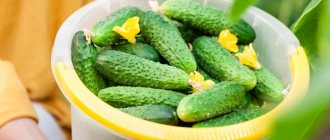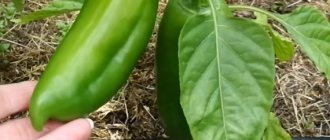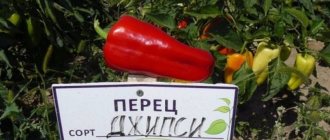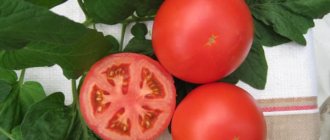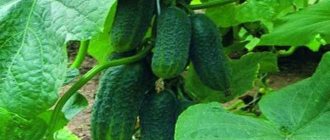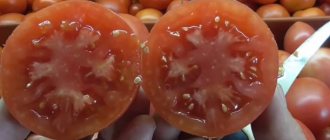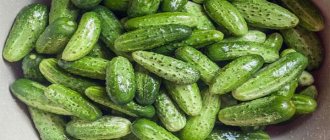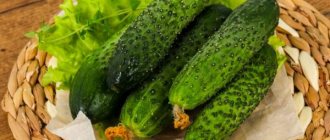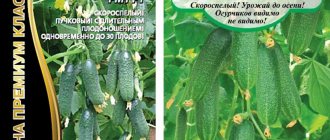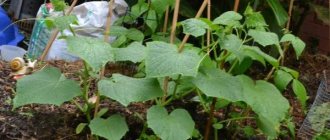The Relay F1 cucumber is a unique hybrid that is grown mainly by farmers, but ordinary gardeners can also plant it on their plots in the summer. It is shade-tolerant, so it is perfect for greenhouses, despite the need for pollination. The taste of the fruit is invariably excellent, and the harvest is plentiful.
| Landing location | Ripening time | Mode of application | Fruit length | Group | Fruit smoothness | Pollination method |
| Universal | Mid-season (56-65 days) | Salad | Long - from 15 to 20 cm | Hybrid | Highly lumpy | Bee pollinated |
Description and characteristics of the variety
The hybrid cucumber variety Relay F1 was created back in the late seventies. He was taken out at the experimental station named after. Edelshtein in Moscow (now the station has joined the agricultural industry. The basis was the Klinsky variety and several shade-tolerant hybrids from Asia, which explains the length of the fruit (the Chinese variety is distinguished by long greens). Since 1983, the hybrid has been listed in the Russian State Register.
It is recommended to grow it in the Northern, Northwestern, North Caucasian, Volga-Vyatka, Central, Central Black Earth and Middle Volga regions. It can be cultivated in winter in heated greenhouses. The hybrid is also suitable for summer cultivation in garden plots.
When grown in greenhouses in winter and early spring, artificial pollination will be required, since the hybrid is bee-pollinated. In garden plots, in order to obtain a harvest, he needs to provide access to insects.
The bushes are powerful, have medium or weak branches, and are covered with large leaves. The fruits ripen 55-60 days after germination of the plantings. The length of greens reaches 15-20 cm. They have a spindle-shaped shape and dark green skin with sparse but large tubercles. There are a small number of white spines. The average fruit weight is 180-230 g.
The taste is wonderful and delicate, the flesh is crispy, juicy, with a pleasant aroma. The fruits are used for salad purposes, since their size is inconvenient for preservation.
What kind of cucumbers grow
Gardeners want to get aromatic sweet cucumbers. The relay fully satisfies this requirement. Breeders have created a hybrid with salad-type fruits.
Description of Zelentsy Relay:
- the greenery is shaped like a spindle;
- color – bright green;
- rare tubercles;
- pubescence white, sparse;
- length – 20 cm;
- diameter in the middle of the fruit - 4 cm;
- taste sweet;
- the pulp is juicy, crispy;
- the skin is tender;
- the seeds are small, not coarse.
Gardeners like the lack of yellowness when overripe. The fruits do not grow longer than 22 cm.
Agronomists recommend eating cucumbers fresh: cutting them into salads or making sandwiches. But the summer residents expanded the purpose. Overgrown greens are preserved for the winter as part of vegetable dishes, small ones are salted and pickled whole.
Advantages and disadvantages
Pros:
- excellent taste;
- high yield, especially for bee-pollinated cucumber;
- shade tolerance;
- the ability to grow in greenhouses even in winter;
- high commercial qualities, keeping quality and transportability, making the hybrid optimal for commercial breeding;
- long fruiting period;
- immunity to mosaic, root rot and many other ailments.
Minuses:
- rather late ripening;
- bitterness is not eliminated at the genetic level and can occur with improper watering;
- vulnerability to true and downy mildew;
- It is impossible to obtain seeds from fruits.
This is interesting
Experienced housewives determine the purpose of cucumbers by the color of the thorns:
- dark spikes – pickling;
- light - for salad.
Main characteristics of “Relay” cucumbers:
- flowering is predominantly female-type;
- bush with weak or medium branching;
- the leaves are large, dark green.
The duration of the growing season of the variety is 55-65 days, after which the first fruits are harvested.
“Relay” is a bee-pollinated variety of cucumbers, but this does not in the least prevent it from leading among greenhouse salad cucumbers.
Landing
Planting of seedlings is carried out 20-30 days before transferring the seedlings to a permanent place. For growing in heated greenhouses, you can sow as early as mid-November, followed by transplanting the bushes into the greenhouse in January. For open ground in the middle zone - around the end of April, in the south two weeks earlier
To prepare the soil, mix equally:
- soil from the garden;
- peat;
- humus;
- sawdust.
Add 0.5 kg of ash to each bucket of mixture. The composition is laid out in small containers with a diameter of 10-12 cm and a volume of 300-400 ml.
Peat cups, cassettes or tablets are suitable for cucumber seedlings. Cucumbers have fragile roots that can be damaged during transplantation, and peat cups can be buried in holes without removing the roots from them.
It is not necessary to disinfect and soak the seeds before sowing, and if they were sold in a colored shell, then it is generally contraindicated. But seed without a shell can be kept for half an hour in a weak solution of potassium permanganate, and then washed and placed in a solution of the stimulant “Epin” or “Zircon” for 6 hours.
2-3 grains are placed in pots to a depth of 1.5-2.5 cm. They are germinated in a warm place at about +25 degrees, after which the temperature is reduced by 5-7 degrees so that the seedlings do not stretch.
When sowing on a personal plot, choose a place protected from the wind, preferably in the sun, although the hybrid also grows in the shade. The soil is prepared in the fall:
- They dig deep.
- Remove old weeds, tops and plant roots.
- Add a bucket of compost or ammonium nitrate to each square meter according to the instructions.
- Check acidity. High levels are harmful to cucumbers. If it is above pH 6-7, add wood ash, dolomite flour, chalk or slaked lime.
In the spring, the soil is disinfected by spilling it with a solution of potassium permanganate or a hot solution of copper sulfate. Bushes can be placed 25-30 cm from each other.
In order for all female flowers to set fruit, Relay cucumbers must be sown with 10% of the bushes of a pollinating variety or hybrid, for example, Gladiator f1.
Yields also depend on temperature: if cucumbers are too warm, they produce mostly male flowers. To avoid this, the bushes are kept at a temperature of +16-17 degrees for 10-12 days before and after transplanting the seedlings.
Fertilizers
Feeding cucumbers should begin with planting seeds. Before sowing, add a mixture of manure and mullein to the holes. During plant growth, it is necessary to add nutrient complexes containing nitrogen. During the formation of ovaries and during fruiting, potassium and phosphorus fertilizers are needed for the development of fruits. Mineral and organic supplements are very important for the full growth and development of cucumbers.
cucumber Ecole F1 - description and characteristics of the variety
Growing and care
In a greenhouse in winter, cucumbers are watered once a week, in open ground - twice a week or depending on the weather. The water is heated and added during periods when the bushes are not exposed to direct sunlight. Do not wet the stems and leaves.
If watering is too poor and during dry periods, the fruits may become bitter.
After watering, carefully loosen the soil.
Feed up to 5 times per season:
- The first two or three feedings should contain mainly nitrogen. Dissolve 1 liter of bird droppings or 1.5 liters of mullein in 15 liters of water and apply a liter of solution under the bush. You can replace it with urea according to the instructions.
- During the flowering period, cucumbers need phosphorus, and during ripening, potassium, which is contained in mineral fertilizers.
- During flowering and fruiting, complex preparations are also effective, for example, Kemira or analogues.
In the greenhouse, the side shoots are pinched, leaving 2-3 leaves, and then the central stem is pinched. In open ground, formation is not necessary.
Fruits should be stored at a temperature of +5-8 degrees; in such conditions they do not lose freshness for about 10 days.
Agricultural technology: what to pay attention to
A bee-pollinated hybrid requires careful care. Only in this case can you count on a good harvest of greens. At the same time, gardeners note that if the rules of care are followed, the plant bears fruit abundantly and for a long time, delighting with the excellent taste of the fruit.
Before planting in the greenhouse, seedlings are grown. In the southern regions, this stage is skipped by sowing cucumber seeds directly into the ground as soon as weather conditions allow.
Growing seedlings
When planning to sow seeds, prepare a nutrient mixture and containers for planting in advance. Cucumber is a crop that does not tolerate picking well, so the seeds are usually sown immediately in separate pots or cups.
The time for sowing seeds is determined taking into account:
- climatic conditions of the region;
- weather;
- conditions in which cucumbers will grow (greenhouse, greenhouse, open ground ridges).
Pests
Of the insect pests at this time, cucumbers should only be wary of spider mites, unless you introduced cockchafer larvae, which do not have a dormant period, into the soil with organic matter. And you most likely brought spider mites from indoor plants.
Ticks can be successfully treated with harmless folk remedies:
- laundry soap solution;
- water infusion or decoction of walnut leaves (even the Colorado potato beetle is afraid of it);
- Infuse crushed garlic in water;
- decoction or infusion of red hot pepper, etc.
Features of the hybrid
Bee-pollinated cucumbers remain in demand among gardeners, and even super-yielding hybrids have not supplanted them from the popularity ratings of the crop.
Since the 80s of the last century, the Relay F1 cucumber has been known, cultivated in industrial production and by amateur gardeners. According to the photographs and description of the variety, this is a salad cucumber suitable for growing in greenhouses and open ground beds. Reviews about it are positive, and the Relay is growing well in all regions of the country. The Relay cucumber is the standard of salad varieties, therefore, during testing, the characteristics of new hybrid forms are often compared with this species. Bred at the famous Moscow breeding station named after V. I. Edelstein, at the moment it is agro. Since 1983, it has been included in the State Register and is recommended for cultivation in all regions of the Russian Federation.
In closed ground it is cultivated on an industrial basis, more often in winter-spring rotation. Summer residents plant Etafeta in summer greenhouses (polycarbonate, film); in the southern regions, the variety grows well on ridges of open ground. Cucumbers require pollination by bees, so when planting in greenhouses it is necessary to attract insects and organize pollination manually. Characterized by the dominance of female flowers, the potential for growth and productivity is high.
Bushes of indeterminate type, weak and medium branching. The leaf blades are wide, large and slightly concave. Color – rich green. Numerous ovaries are formed both on the main stem and in the axils of the side shoots. The period until the first green plants fully ripen from the moment of germination is 53-58 days.
The yield of fruits is stable, the plant quickly adapts to weather conditions. The ovaries are formed singly, which greatly simplifies the care of the crop.
Zelentsy are long and shaped like a spindle. The skin is bright green, with sparse tubercles and sparse whitish pubescence. The length of the cucumbers is 18-22 cm, there is no tendency to overgrow or turn yellow. On average, the diameter of the fruit reaches 3-4 cm. Greens are collected small (used for pickles, canned food), and also at the stage of biological full maturity (for salads). The taste is sweetish and pleasant. The pulp is very juicy, with a crunch, there are a lot of seeds, but they are small and not coarse.
Summer residents rate the quality of cucumbers highly, noting the excellent taste of Relay and the presence of a characteristic cucumber crunch. In the State Register catalog, Relay is classified as a salad-type cucumber, but greens are excellent for processing. Small fruits are used for pickling, and many gardeners also preserve and pickle Relay greens in slices. When prepared, the fruits hold their shape, retain high taste characteristics and rich color.
Yield indicators for closed soil are up to 40-44 kg/m². But such results are achieved only with proper care and proper formation of the bushes, ensuring a stable temperature regime. On average, the yield is 20-25 kg/m², which is also impressive.
The first generation hybrid Relay F1 is a cucumber with many advantages. Among them:
- good yield (especially when grown in greenhouses);
- versatility of using greens;
- long period of fruiting of the crop;
- the variety tolerates slight shading;
- leveled fruits;
- resistance to major crop infections, including cucumber mosaic virus. Tolerant to root rot;
- a simple scheme for pinching a plant;
- marketability;
- keeping quality of the fruit (according to reviews, cucumbers can be stored in cool conditions for up to 2 weeks without loss of taste);
- excellent taste characteristics;
- gradual ripening of cucumbers, absence of significant overload of the plant.
Flaws:
- if there is a lack of moisture, the fruits become slightly bitter, so when caring for them, pay special attention to watering;
- at elevated temperatures at night, many male flowers are formed (barren flowers);
- You cannot collect seeds for subsequent plantings. The relay belongs to the first generation hybrids, labeled F1.
A bee-pollinated hybrid requires careful care. Only in this case can you count on a good harvest of greens. At the same time, gardeners note that if the rules of care are followed, the plant bears fruit abundantly and for a long time, delighting with the excellent taste of the fruit.
Before planting in the greenhouse, seedlings are grown. In the southern regions, this stage is skipped by sowing cucumber seeds directly into the ground as soon as weather conditions allow.
Growing seedlings
When planning to sow seeds, prepare a nutrient mixture and containers for planting in advance. Cucumber is a crop that does not tolerate picking well, so the seeds are usually sown immediately in separate pots or cups.
The time for sowing seeds is determined taking into account:
- climatic conditions of the region;
- weather;
- conditions in which cucumbers will grow (greenhouse, greenhouse, open ground ridges).
It is advisable to select containers with a volume of 0.5 liters so that the seedlings grow strong and healthy. Nutrient soil is used ready-made or various components are mixed independently.
- turf land;
- humus (peat);
- calcined river sand (vermiculite, perlite, steamed crushed sawdust).
Proportions: 2:2:1. Seeds are sown 1-2 per pot, after germination the strongest sprout is left.
- in the middle zone for greenhouse cucumbers - from April 15 (with planting in greenhouses in mid or late May);
- in the middle zone for open ground cucumbers - in early May (planting on ridges - in early June);
- in the regions of the North-West, Siberia, and the Urals - early May (landing at the end of the month or early summer).
The seedlings are provided with a stable temperature regime and regular irrigation. If the soil mixture contains fertilizers, then no additional fertilizing is carried out. In case of growth retardation and weak plants, seedlings are fed 1-2 times with complex fertilizer or a ready-made compound (Agricola, Kemira).
Hardening off the seedlings is a must, as such plants quickly adapt to new conditions when planted, take root well, and do not get sick. Hardening begins 10 days before the planned transplant.
The time for transplanting seedlings from pots to ridges or to a greenhouse is determined by the weather. Warming up the soil - up to 14ºC... 15ºC. Some summer residents cover the surface of the ridges with black film, so the earth warms up faster.
READ MORE: Pickled bitter capsicum for the winter recipes with photos
Planting cucumbers after green manure shows good results. Trellis are prepared in the shelter by equipping supports and stretching rope or wire.
Seedlings are planted 2-3 plants per square meter. This variety does not tolerate thickening and requires large areas for feeding the roots and above-ground parts. Dense planting leads to poor lighting and infections. It is recommended to replant varieties of pollinators, and select plants with similar flowering periods, but with a large number of male flowers (Casanova, Gladiator, Lefty).
When growing, the main attention is paid to fertilizing, compliance with light and temperature conditions, and watering. Immediately after planting the seedlings, the plants are not watered for 4-6 days for better growth and root formation. Next, water as the soil dries, in the holes, in the grooves between the rows, with control of air humidity. The schedule is determined taking into account the weather; in hot weather, watering is done daily.
In extreme heat, it is recommended to spray the plantings (in the morning or late afternoon), and provide slight shading of the greenhouse (treating the roof surface with chalk solution). Optimal air humidity is 80-85%. To maintain humidity and the required temperature, barrels of water are placed in the shelters. During the day, the water in the containers heats up, and during the night it releases heat into the air inside the greenhouse.
After watering, the soil is loosened, preventing the formation of a hard crust. The use of mulch shows good results. To do this, cut grass, hay, humus, compost, and peat are laid out between the plants. Layer – 8-10 cm. Mulch simplifies maintenance, prevents the appearance of crust on the soil surface, compacts the soil, and prevents weeds from growing.
A powerful hybrid with high yields requires adequate feeding. The first feeding is done when the third true leaf appears on the seedlings, the next feeding is at the beginning of flowering. At the first stage (before flowering), organic matter is added; after flowering and during the fruiting stage, priority is given to potassium and phosphorus compounds.
In order not to calculate proportions, it is easier to use ready-made compounds for fertilizer: complex fertilizers or purchased products. Sudarushka, Kristalon, Agricola No. 5 are suitable for cucumbers. From organic matter, it is advisable to use diluted mullein, bird droppings, and wood ash (infusion).
Cucumbers respond well to watering with solutions of yeast, onion peels, and spraying the leaves with boric acid and an iodine-milk composition. The last resort is not only feeding, but also prevention from the appearance of fungal diseases.
Proper formation of plants helps to accelerate fruiting and increase the number of ovaries and fruits. The bee-pollinated hybrid is grown with obligatory blinding of the nodes of the lower tier (up to 50 cm) and pinching of the lashes, taking into account the growth zones. According to the standard scheme, pinching is carried out zonally, gradually leaving from one to 3 leaves and greens on the side lashes.
To pollinate Relays, bees are attracted to shelters. The plantings are sprayed with a sugar solution, the doors and windows are opened, and honey plants (calendula, mint, fennel) are planted in the spring. In small greenhouses in cloudy weather and in the absence of insects, manual pollination is recommended.
The fruits are collected as they ripen on the bushes. For pickles and preservation, it is advisable to remove small herbs, for salads - at full maturity.
Reviews
In the greenhouse for a number of years I have been planting 4-5 bushes of the hybrid Relay. We are provided with cucumbers until the fall. I use them only in salads and fresh, although my mother-in-law makes preparations. The hybrid is very successful, although it requires pollination. I don't bother with hand pollination, usually the days are warm anyway and there are a lot of bees flying around during the flowering stage. Of the salad cucumbers, this is considered the best.
